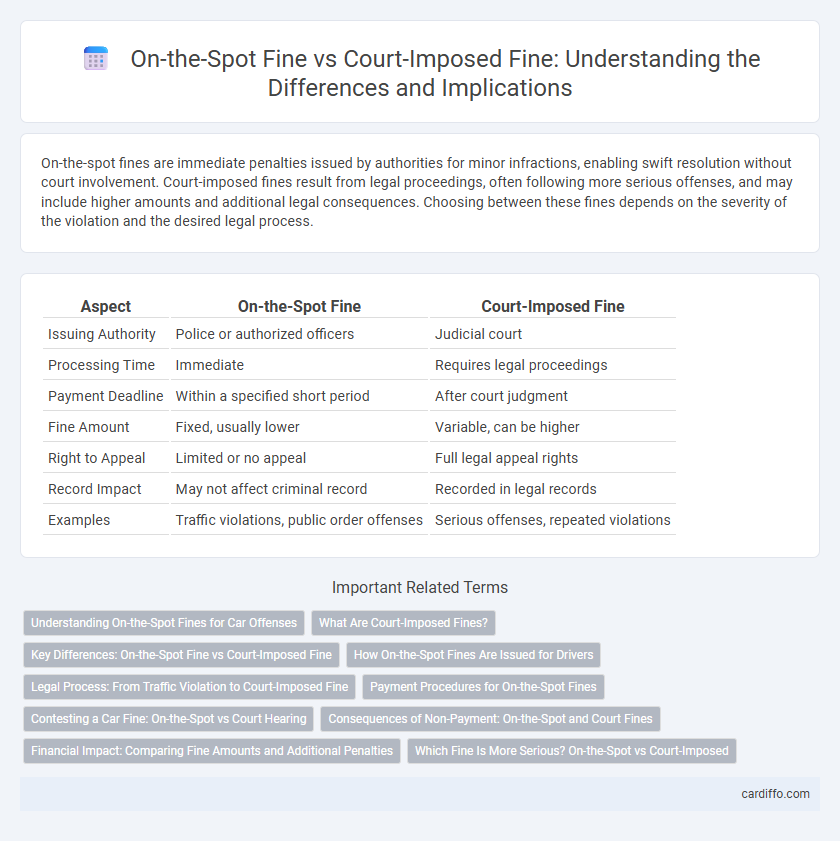On-the-spot fines are immediate penalties issued by authorities for minor infractions, enabling swift resolution without court involvement. Court-imposed fines result from legal proceedings, often following more serious offenses, and may include higher amounts and additional legal consequences. Choosing between these fines depends on the severity of the violation and the desired legal process.
Table of Comparison
| Aspect | On-the-Spot Fine | Court-Imposed Fine |
|---|---|---|
| Issuing Authority | Police or authorized officers | Judicial court |
| Processing Time | Immediate | Requires legal proceedings |
| Payment Deadline | Within a specified short period | After court judgment |
| Fine Amount | Fixed, usually lower | Variable, can be higher |
| Right to Appeal | Limited or no appeal | Full legal appeal rights |
| Record Impact | May not affect criminal record | Recorded in legal records |
| Examples | Traffic violations, public order offenses | Serious offenses, repeated violations |
Understanding On-the-Spot Fines for Car Offenses
On-the-spot fines for car offenses provide an immediate penalty issued by law enforcement at the scene, offering a swift resolution without court involvement. These fines encourage prompt payment and reduce the administrative burden on courts by addressing minor infractions like speeding or illegal parking. Understanding the specific conditions and payment deadlines of on-the-spot fines helps drivers avoid additional penalties or legal complications.
What Are Court-Imposed Fines?
Court-imposed fines are monetary penalties ordered by a judge following a legal proceeding, typically after a defendant is found guilty of a violation or crime. These fines vary based on the severity of the offense, jurisdictional guidelines, and the individual circumstances of the case. Unlike on-the-spot fines, court-imposed fines often include court fees and may result in additional consequences such as probation or license suspension.
Key Differences: On-the-Spot Fine vs Court-Imposed Fine
On-the-spot fines are issued immediately by enforcement officers for minor infractions, allowing swift penalties without court involvement. Court-imposed fines result from legal proceedings and are typically reserved for more serious offenses, requiring a judge's decision. The key difference lies in immediacy and procedural complexity, with on-the-spot fines offering quicker resolution compared to court-imposed fines that involve formal legal review.
How On-the-Spot Fines Are Issued for Drivers
On-the-spot fines for drivers are issued immediately by law enforcement officers at the scene of the traffic violation, allowing for swift penalty enforcement without the need for a court hearing. These fines are typically applied for minor infractions such as speeding, illegal parking, or running a red light, ensuring prompt compliance and reducing administrative backlog. The driver is usually required to pay the fine within a specified period to avoid further legal action or court proceedings.
Legal Process: From Traffic Violation to Court-Imposed Fine
Traffic violations often result in an on-the-spot fine, allowing officers to resolve minor infractions immediately without court involvement. If the violator contests the ticket or fails to pay the immediate fine, the case escalates to the legal process involving a court hearing where a judge may impose a higher fine. This court-imposed fine follows formal procedures, including summons issuance, legal representation, and potential evidence presentation, ensuring due process and fair adjudication.
Payment Procedures for On-the-Spot Fines
On-the-spot fines require immediate payment at the location of the offense, typically through cash, credit card, or mobile payment systems, facilitating swift resolution. These penalties must be settled within a stipulated timeframe, often ranging from 24 to 72 hours, to avoid escalation into court proceedings or additional fees. Failure to comply with payment procedures for on-the-spot fines can lead to increased penalties, legal action, or mandatory court appearances.
Contesting a Car Fine: On-the-Spot vs Court Hearing
Contesting a car fine involves choosing between an on-the-spot fine dispute and a court hearing challenge, each with distinct procedures and outcomes. On-the-spot fine appeals typically require immediate evidence submission and can result in quick resolutions, whereas court-imposed fine contests involve formal legal representation and extended hearings. Evaluating factors such as evidence availability, fine severity, and legal advice helps in deciding the most effective method to contest a car fine.
Consequences of Non-Payment: On-the-Spot and Court Fines
Non-payment of on-the-spot fines typically leads to increased penalties, enforcement actions, and potential license suspensions, as these fines are designed for immediate compliance. Court-imposed fines, when unpaid, can result in warrants, additional fines, or even imprisonment, reflecting the judicial system's enforcement measures. Both types of fines carry serious consequences that escalate with continued non-payment, affecting legal records and financial standing.
Financial Impact: Comparing Fine Amounts and Additional Penalties
On-the-spot fines typically involve fixed amounts set by law enforcement, offering immediate payment options that avoid court costs and lengthy legal processes. Court-imposed fines can vary widely depending on the offense's severity and may include additional penalties such as legal fees, interest, or probation costs, increasing the overall financial burden. Choosing an on-the-spot fine often reduces total expenses, while court fines carry risks of higher amounts and supplementary charges.
Which Fine Is More Serious? On-the-Spot vs Court-Imposed
On-the-spot fines are typically issued immediately for minor violations and are generally less severe, resulting in faster resolution but limited appeals options. Court-imposed fines, however, arise from formal judicial proceedings, carry higher penalties, and may include additional legal consequences such as points on a license or imprisonment. The court-imposed fine is usually more serious due to its potential for greater financial impact and lasting legal ramifications.
On-the-spot fine vs court-imposed fine Infographic

 cardiffo.com
cardiffo.com